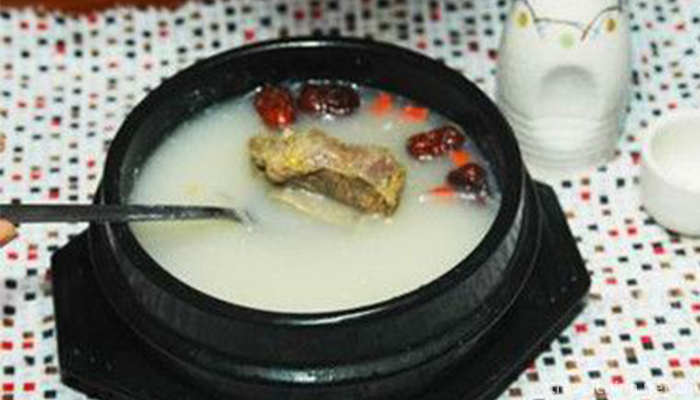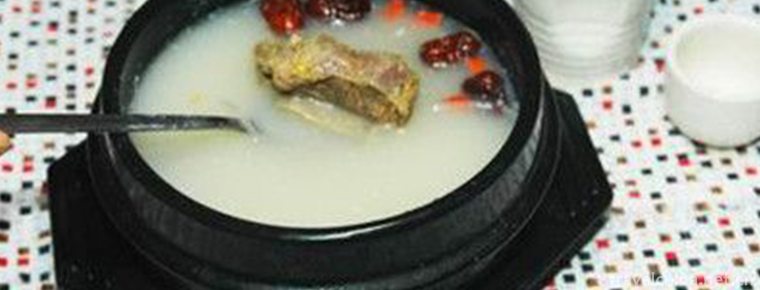Eight Diagrams porridge
Eight Diagrams porridge
Bagua porridge is derived from "Chinese recipe for longevity". Its main ingredients are turtle and japonica rice. It is made by boiling with other auxiliary ingredients. It can play a health role of tonifying Yin and prolonging life.
Essential information
Processing: Boiling Taste: Fresh Flavor Ingredients: Turtle (500g) Japonica Rice (200g)
Accessories: Walnuts (50g)
Condiments: lard (refined) (50g) sesame oil (5g), onion (15g), pepper (5g), ginger (10g) salt (2g) monosodium glutamate (1g)
Category: Fast food/staple food nourishing deficiency, nourishing body, regulating qi and blood, nourishing Yin after operation
Origin: Legend has it that Zhu Yuanzhang ran to a broken temple in a battle before he was emperor. At that time, he was very hungry. A soldier finally found some food in the rat hole and made porridge for Zhu Yuanzhang to drink. The number is exactly eight. Finally, Zhu Yuanzhang became emperor. When he remembered the past, he called the life-saving food Babao porridge. Later, people thought it was delicious, and it was handed down!
December 8th of the lunar calendar is the Laba Festival in China. People have the habit of eating Laba porridge. Laba porridge is also called Babao porridge. According to legend, Laba Festival is the day when Buddha "became a Tao". Buddhist temples should imitate the story of shepherd's maid's sacrifice of rice and fruit to make porridge for Buddha. So it is called Babao porridge. Laba porridge is simple in preparation, rich in nutrition and sweet in taste. In the Song Dynasty, the folk followed suit and became a popular delicacy.
On the eighth day of the eighth lunar month, Buddhist monks and nuns often cook eight kinds of food together, such as glutinous rice, sesame, bud seeds, Guiyuan, dates, mushrooms and lotus seeds. They invite the people around the mountain to have a holy meal and give alms to the people's families, old and young, in order to show their respect for Buddha's ancestors. Later, it gradually became a folk self-cooked porridge (Laba porridge) for consumption. The custom of eating Laba porridge was formed.
On December 8 of the lunar calendar, the ancient monasteries used to cook porridge and worship Buddha with mixed grain and fruit. Folk people also used to cook porridge on the eighth day of the eighth lunar month to eliminate disasters and diseases. Laba porridge was boiled with walnuts, pine nuts, mushrooms, persimmons, chestnuts and rice in Hangzhou during the Song Dynasty. Laba porridge was popular throughout the Ming and Qing Dynasties.
Laba porridge is nominally full of eight raw materials, but it is not rigid. There are four or five kinds of porridge, and more than a dozen kinds of porridge. In some places, Laba porridge is boiled with glutinous rice, brown sugar and 18 kinds of dried fruits and beans, which is very grand. With lotus seeds, ginkgo, peanuts, red dates, pine nuts and ginger cinnamon and other spices mixed into rice to boil Laba porridge, take its warm hands and feet, nourishing the body. There are also Laba porridge boiled with cowpea, golden needle, agaric, tofu, mushroom and so on. These are "fine Laba". Laba porridge eaten by ordinary people, mixed with vegetables, soybeans, broad beans, tofu, carrots and water chestnut, is the so-called "coarse Laba". In some places of northern China where rice is not produced or produced less, people do not eat Laba porridge, but Laba noodles. The next day, we use all kinds of fruits and vegetables to make pickles and roll out noodles. On the eighth morning of the eighth month of December, the whole family will eat Laba noodles. In some mountainous areas where maize is produced, when Laba comes, maize is used instead of rice to make "Laba Mairen" to eat. Farmer's custom is to make Laba porridge every day. Laba porridge is all that you have at home. Everything delicious and edible can be put in a pot in an appropriate amount. Soybean, mung bean, cowpea, pea, eggs, potato, carrot and wheat flour, corn flour, sorghum flour, barley flour, etc. can be boiled into a pot of porridge. It is often said that you eat well and grow well.
December, is a year to come. We must eat all kinds of cereals and vegetables throughout the year, so that we can have comprehensive nutrition. This is to pray for human health, family prosperity! Next is to eat all, harvest all, after the month of December, it will be a new year. When eating Laba porridge, we will eat all kinds of cereals and vegetables that grew in the field in that year and refuse to give up anything. This shows that farmers cherish everything they harvest on the land. We hope that in the new year, all crops will grow well and be rich.
Manufacturing process
1. Strike the hard bones on both sides of the living turtle with an axe, uncover the shell, remove the bottom plate, and clean up the meat and viscera of the turtle (turtle shell, bottom plate is not used). Cut scallions and pat ginger.
2. Add lard, pepper, scallion, ginger, fried fragrance, pour turtle meat and viscera and walnut kernels into the container, sprinkle with sesame oil, add salt after 5 minutes of high heat, add 1500 grams of water, boil water, add japonica rice and low heat for 20 minutes until porridge is thick.
3. When eating, add a little monosodium glutamate, onion (cut flowers) flower flavor.
dietary nutrition
Turtle: Turtle has a high edible value. Turtle meat is very delicious and nutritious. Turtle meat and its extracts can effectively prevent and inhibit liver cancer, gastric cancer and acute lymphoblastic leukemia, and can be used to prevent and treat weakness, anemia and leukopenia caused by radiotherapy and chemotherapy. Turtle also has a good blood purification effect. Regular eaters can reduce blood cholesterol, which is beneficial to patients with hypertension and coronary heart disease. Turtle can also "repair work injury, strengthen Yang Qi, greatly fill the deficiency of Yin". Turtles also have some adjuvant effects on pulmonary tuberculosis, anemia, physical weakness and other diseases. Turtle meat is flat and sweet, with the functions of nourishing yin, cooling blood, tonifying kidney and strengthening bone, dispersing knots and eliminating ruffian.
Japonica rice: Japonica rice can improve human immune function, promote blood circulation, thereby reducing the chance of hypertension; Japonica rice can prevent diabetes, beriberi, senile plaque and constipation and other diseases; Japonica rice bran layer of crude fiber molecules, help gastrointestinal peristalsis, gastric diseases, constipation, hemorrhoids and other curative effects are very good.
Walnuts: Walnuts are popular snacks. They are rich in protein, fatty acids and B-group food.


-
2.The classical gardens of Suzhou
The classical gardens of Suzhou / Suzhou classical gardens, referred to as Suzhou gardens, are world cultural heritage, national AAAAA class tourist attractions
Time 2018-12-06 -
3.Shanghe Garden Scenic Spot in Qingming Dynasty
Qingming Shanghe Garden is a large-scale theme park of Song Dynasty cultural scenery constructed by the people's government of Kaifeng City in Henan Province
Time 2019-02-07 -
4.Tianjin Italian Style Area
Tianjin Italian Style Area is located in Hebei District of Tianjin City. It is a quadrangular area surrounded by Wujing Road, Boai Road, Shengli Road and Jianguo Road in Hebei District. There are near
Time 2019-02-21 -
5.Eight polar boxing
Bajiquan is a kind of boxing in Chinese Wushu. The word "eight poles" of this boxing method originated from the concept of Palaeogeography and originated from the Han Dynasty
Time 2019-04-02 -
6.Nail twist Jiaru jiacuo
Jiaru is a traditional dance of Mosuo people in Lugu Lake, Yunnan Province. It is a song and dance for people to celebrate harvest, festivals and pray for gods.
Time 2019-05-05 -
7.Mangkang Trichord Dance
Sanxian Dance originated in Quzika Township, Mangkang County, Changdu District. It has the unique charm of simplicity, elegance, melodiousness and ease, and is deeply loved by the masses. Passengers p
Time 2019-05-22 -
8.Qianshan Temple Music
Qianshan, located 20 kilometers southeast of Anshan City, Liaoning Province, is one of the most famous scenic spots in the country. In the northeast, Qianshan is as famous as Changbai Mountain in Jili
Time 2019-06-10 -
9.Qiangge war
The Battle of the Qiang is the most famous one among the folk epics of the Qiang people. It describes the history of the ancestors of the Qiang people who had experienced hardships and hardships
Time 2019-06-10 -
10.Shandong Qinshu
Shandong Qinshu is one of the traditional folk art varieties in Shandong area, also known as "Xiaoqu", "Yangqin", "Shandong Yangqin", "improved Qinshu" and so o
Time 2019-06-13 -
11.Brick and plastic
Brick sculpture is the handicraft of folk craftsmen. It is made of mud into various animal models. Some of the images are realistic, but more are romantic and exaggerated ways of expression, the shape
Time 2019-08-10 -
12.Zhang Daqian
Zhang Daqian (Chang Dai-Chien, May 10, 1899 - April 2, 1983), formerly known as Zheng Quan, was renamed as yuan, Ji Yuan, Hao Da, alihao Dai Ju Shi, Xia Li Hong Kong people, Zhai Da Feng Tang. Sichuan
Time 2019-09-04